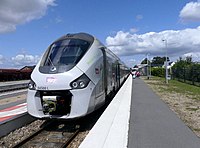
Photo from wikipedia
Abstract Considering the low cetane number of biodiesel blends and alcohols, ignition promoter additives 2-ethylhexyl nitrate (EHN) and di-tertiary-butyl peroxide (DTBP) was used in this study at a proportion of… Click to show full abstract
Abstract Considering the low cetane number of biodiesel blends and alcohols, ignition promoter additives 2-ethylhexyl nitrate (EHN) and di-tertiary-butyl peroxide (DTBP) was used in this study at a proportion of 1000 and 2000 ppm to diesel-biodiesel-pentanol blends. Five carbon pentanol was used at a proportion of 10% with 20% jatropha biodiesel-70% diesel blends and engine testing was carried out in a single cylinder DI diesel engine. The fuel properties, engine performance, emission and combustion were studied and mainly the effects of two most widely used ignition promoter on the engine behaviour were compared and analyzed. Experimental results indicated that, the fuel properties like density (0.36–1.45%), viscosity (0.26–3.77%), oxidation stability (5.5–26.4%), cetane number (2–14.58%) are improved remarkably with a moderate change in calorific value for the pentanol and ignition promoter treated biodiesel blends depending on the proportion used and for different benchmark. The brake power (BP) is developed very slightly (0.66–1.52%), which is still below than that of diesel, however, the brake specific energy consumption (BSEC) decreased significantly (0.92–5.84%). Although mixing of pentanol increased the nitric oxide (NO) (2.15% than JB20) with reducing the hydrocarbon (HC), carbon monoxide (CO) and smoke, however, the addition of EHN and DTBP reduced the NO (2–4.62%) and smoke (3.45–15.5%) emissions showing higher CO (1.3–9.15%) and HC (5.1–17.87%) emission based on percentage of ignition promoter used. The NO emission from the peroxide ignition promoter treated fuel blends are consistently lower than those for the nitrate ignition promoter treated fuel blends at similar cetane level. The combustion pressure (CP) and heat release rate (HRR) of the ignition promoters added blends are improved showing advanced combustion pressure (0.11–0.53 bar) and lower heat release rate (0.82–2.29 J/°CA). In conclusion, it can be said that, pentanol and ignition promoters are promising additives for biodiesel blends for improving overall performance of a diesel engine.
Journal Title: Energy Conversion and Management
Year Published: 2017
Link to full text (if available)
Share on Social Media: Sign Up to like & get
recommendations!